The Mining History Centre - Winner 2017
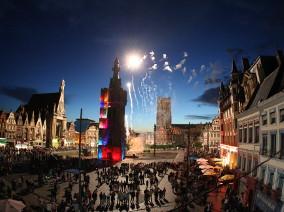
Winner in the Cultural Tourism category
The Mining History Centre (Centre Historique Minier) sits in the heart of a coalfield, at Lewarde in North-Western France, 8km from Douai. Follow 150,000 yearly visitors and stop by the museum, where you can plunge deep into the world of mining. A unique industrial and human adventure!
What makes Mining History Centre special?
The Mining History Centre is France's largest mining museum. See themed exhibitions to learn about how coal forms, the history of the region's mining era and the daily lives of miners and their families. Not a Francophone? There are audio guides in English, German, Dutch, Polish, Italian and Spanish. Follow the exhibition up with a guided tour of the galleries. Step into the miners’ underground world, recreated by the throbbing of the machines and projected images to help you imagine the miners at work. Finish the visit by meeting a former miner who will share his experiences (French only).
Cultural tourism
The Centre Historique Minier illustrates 270 years of history of coal mining in the North of France. The museum is located at the former Delloye pithead. It is a historical monument and a UNESCO World Heritage site. Experience the pit galleries, enhanced by commentary, running machinery and audio-visual elements. Finish up with a visit to authentic industrial buildings and exhibitions.
The Centre Historique Minier has presentations tailored to various groups, families and students. It has an inclusive policy with procedures and equipment to welcome disabled people.
Energy and sustainable development are crucial for society today. With this in mind, the museum's future developments focus on its centre for energy-related scientific culture (CCSE). This is building up to a new dedicated area opening in February 2019.
Sightseeing tips
- Guided tour of the galleries
Cross the staff footbridge to the coal breaker and sorting area where women and young miners sorted coal. See the galleries, and learn how the working techniques and conditions underground evolved between 1720 and 1990. - authentic workplaces at Delloye colliery
Enter the former colliery, with clothes hanging in the bathrooms, a horse neighing in the stables and the enormous wheels of the extraction machines. Step into a 1930's office to meet the accountant and miner's representative. - 7 exhibitions in the heart of an industrial and social adventure
These include: 'the origins of coal': a geological lesson in coal formation, 'life in a mining village': a complete account of a miner and his family life, 'the 3 ages of the mine': an illustration of a 270-year evolution
More information
- Centre Historique Minier website (in English)
- EDEN video about Centre Historique Minier - Winner 2017
- EDEN contact for Centre Historique Minier: contact
 chm-lewarde [dot] com (contact[at]chm-lewarde[dot]com)
chm-lewarde [dot] com (contact[at]chm-lewarde[dot]com)
Tournus et le Tournugeois - Winner 2015
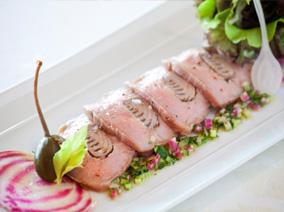
Winner in the Tourism and Local Gastronomy category
Tournus is the capital of Turnougeois in Burgundy. Here, monuments and picturesque streets come alive throughout the year with markets, concerts, exhibitions and other activities.
Tournus is an emerging destination, off the beaten track in the south of Burgundy. It has easy access, a strong heritage and since 2012, new gastronomic opportunities, satisfying one of the most sought-after features for tourists visiting France.
In recent years, Tournus has gained an international reputation for gastronomy thanks to its land, wine and the culinary traditions of Burgundy.
What makes Tournus special?
A land of history. The Tournus area is home to architectural treasures like St Philibert Abbey, the only complete monastery building conserved in Europe. Visitors can also dicover an exceptional cultural heritage: the Hotel Dieu – Musée Greuze, the Michel Grézaud Bicycle Museum, the medieval village Brancion (10h-14th centuries) and the Cave des Vignerons de Mancey.
Land of taste. Tournus is an unmissable place for gastronomy with 4 Michelin-starred chefs, many restaurants and local producers. It is also a place of tradition. Discover its soil, the display of the wines, the climate and the expertise of its makers of sublime Chardonnay wines.
Land of creation and events. Tournus is a creative place with many artists, craftspeople and antique dealers who share their knowledge and passion by opening up their workshops, galleries and shops to the public. The city also holds the regional arts and crafts fair every two years, as well as the the Franco-Gourmandes event, a music and gastronomy festival.
Local gastronomy
Tourism in Tournus is strongly marked by the local gastronomy. It has four Michelin-starred chefs, many restaurants and local producers. Also, its soil, the exposure of the wines, the climate and the expertise of its wine-makers lay the foundation for the sublime Chardonnay wines.
Sightseeing tips
- Visit the monks at St Philibert’s Abbey, the only complete monastery building conserved in Europe. With world renowned masterpieces of Romanesque art, St Philibert's Abbey welcomes hundreds of thousands of visitors every year.
- See the Wine Growers of Mancey, a space dedicated to the vineyards and the wines of Burgundy.
- Attend the Franco-Gourmandes festival, the first music and gastronomy festival in the region, organised in June every year.
More information:
- The official website of Tournus et le Tournugeois
- EDEN video about Tournus et le Tournugeois
- EDEN contact for Tournus et le Tournugeois: ot-compta
 tournugeois [dot] fr (ot-compta[at]tournugeois[dot]fr)
tournugeois [dot] fr (ot-compta[at]tournugeois[dot]fr)
Morvan Region Nature Park - Winner 2013
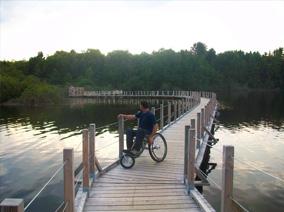
Winner in the Accessible Tourism category
The Morvan Regional Natural Park is a craggy mountainous massif.
It offers natural and cultural heritage, and exceptional landscapes ideal for discovering the environment and practising outdoor sports.
Known as 'The Lungs of Burgundy', the park represents a large natural stadium offering a wide range of outdoor activities, from trekking to biking, horse-riding, kayaking and rafting.
Morvan is also an area of history and traditions. Vezelay, a UNESCO World Heritage Site, is a departure point for the Camino de Santiago, a pilgrimage trail to Santiago de Compostela in Spain.
Morvan offers a network of different museums and eco-museums around the theme of 'exchanges and migration'. It also hosts a series of festivals, shows and events throughout the year.
Accessibility
The programme 'Morvan pour tous' ('Morvan for everyone') has been implemented since 2006 to develop sustainable tourism which is accessible for everyone - handicapped and non-handicapped.
The Morvan Regional Natural Park became a destination of excellence and accessible tourism thanks to the involvement of the associations, tourism sector and service providers.
Several accessible events and activities have been developed:
- Nature treks for everyone: multi-sport, handicap-friendly treks with outdoor activities open to everyone
- A pool of suitable material available for free, using different technical solutions to enable outdoor leisure activities as varied as walking, swimming, fishing, sensory climbing and off-road wheelchair downhill riding
- Thematic tours and visits adapted to persons with disabilities
- A large number of shops, sites or visits with the label 'Tourism and Handicap'.
Sightseeing tips
- Try the rock-climbing wall for the visually impaired.
- Follow the discovery path in the park centre, suitable for many disabilities.
- Participate in one of the ongoing outdoor sports and handicap fair events.
More information:
- The official website of Morvan Regional Nature Park
- See the EDEN video about Morvan Regional Nature Park:
- Long version (3 minutes)
- Short version (1 minute)
- EDEN contact for Morvan Regional Nature Park: morvanpourtous
 parcdumorvan [dot] org (morvanpourtous[at]parcdumorvan[dot]org)
parcdumorvan [dot] org (morvanpourtous[at]parcdumorvan[dot]org)
Roubaix - Winner 2011
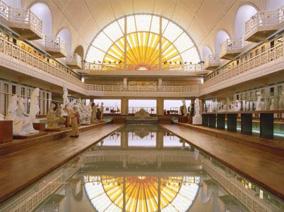
Winner in the Tourism and Regeneration of Physical Sites category
Roubaix is a small city situated in northern France, close to the city of Lille.
Founded in the 9th century, it is the second biggest city in the Nord-Pas de Calais region, with a population of around 100,000.
In the Middle Ages, Roubaix was famous for its textile industry and wool production.
Today, the city is also well known for its policy on regeneration 'Ville Renouvelée', which seeks to transform this industrial setting into a sustainable city.
Roubaix has undergone many changes which have transformed the facade of the city whilst maintaining its heritage and charm. An example of one such metamorphosis is an old swimming pool that was converted into a museum of fine arts.
This and many other developments have made Roubaix a unique destination worth visiting.
Regeneration and revival
Local authorities in Roubaix see culture and heritage as the key to the city’s economic recovery, and various sites have been given new life – from a garage converted into a theatre, to a swimming pool which now functions as a museum.
The swimming pool was built in 1932 by Albert Baert and was one of the finest and most sophisticated of its time. It was a strong symbol of Roubaix identity until it was closed in 1985 due to safety concerns.
It was the community’s attachment to the building that certainly saved it from being demolished.
In 2001, following an international competition, the swimming pool was reopened as a museum – ‘La Piscine – Musee d’art et d’industrie’. The facade of the building was preserved, while the interior was adapted to host permanent and visiting exhibitions.
La Piscine highlights the industrial past of the city, exploring its cultural heritage and offering visitors an insight into the city’s history.
Sightseeing tips
- The famous Paris-Roubaix bicycle road race ends in Roubaix. See if you can spot the names of biking legends engraved in stone along the city’s cobbled roads.
- Visit Roubaix’s fashion district and ‘A l’Usine’ – a former factory turned outlet store.
- Carolyn Carlson is the Director of the National Choreographic Centre in Roubaix, famous for its unique dance performances.
More information
- The official website of Roubaix
- See the EDEN video about Roubaix:
- Long version (3 minutes)
- Short version (1 minute)
- EDEN contact for Roubaix: direction
 roubaixtourisme [dot] com (direction[at]roubaixtourisme[dot]com) or contact
roubaixtourisme [dot] com (direction[at]roubaixtourisme[dot]com) or contact roubaixtourisme [dot] com (contact[at]roubaixtourisme[dot]com)
roubaixtourisme [dot] com (contact[at]roubaixtourisme[dot]com)
Grand Site du Marais Poitevin - Winner 2010
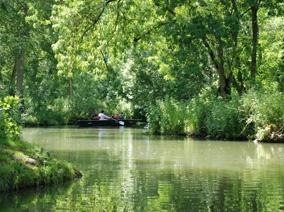
Winner in the Aquatic Tourism category
The Marais Poitevin is situated close to Ile de Ré, Châtelaillon-Plage on the Atlantic coast.
This labyrinth of waterways, lined with tall and dense vegetation, is the largest wooded marshland on the Atlantic coast (49,000 hectares) and has one of the richest natural habitats in France. The long winding paths can be explored on foot, by bike or by carriage.
The characteristic landscape of the Marais Poitevin has featured in numerous artistic representations and productions.
Over the years painters, watercolourists, storytellers, writers, photographers and artists have captured the history and imagination of the spirit of this mysterious and unusual world.
What makes the Marais Poitevin special?
The landscapes of the wet marsh are made up of two highly characteristic elements that exist side by side: the river system, with a sophisticated hierarchy of waterways, and the flora, which brings volume, colour and different perspectives with its ash trees, poplars, willows and alders.
The landscape changes from an open lattice work of different shades of grey in winter, to a place of hidden scenery in summer - dominated by multiple shades of green that invites you to sit and meditate in the shade of the foliage, along canals covered in duckweed.
Don't miss...
- the remarkable vestiges of the 9th century churches in Saint-Michel-en-l’Herm, Maillezais and Nieul-sur-l’Autise.
More information
- The official website for the Grand Site du Marais Poitevin
- Watch the EDEN video about t he Grand Site du Marais Poitevin:
- Long version (3 minutes)
- Short version (1 minute)
- EDEN contact for the t he Grand Site du Marais Poitevin: s [dot] leridant
 parc-marais-poitevin [dot] fr (s[dot]leridant[at]parc-marais-poitevin[dot]fr) or s [dot] guiheneuf
parc-marais-poitevin [dot] fr (s[dot]leridant[at]parc-marais-poitevin[dot]fr) or s [dot] guiheneuf parc-marais-poitevin [dot] fr (s[dot]guiheneuf[at]parc-marais-poitevin[dot]fr)
parc-marais-poitevin [dot] fr (s[dot]guiheneuf[at]parc-marais-poitevin[dot]fr)
Northern Vosges Regional Natural Park - Winner 2009
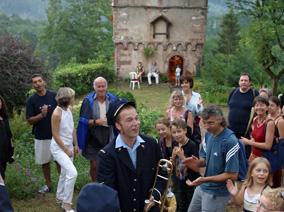
Winner in the Tourism and Protected Areas category
The Northern Vosges Regional Natural Park is situated in the Alsace and Lorraine regions in north-eastern France. It consists of forests, wetland, farmland and a range of historical and cultural sites.
With the century-old Club Vosgien at the helm, the park maintains a superior maze of over 1,650km of hiking paths. In addition to this, there are over 900km dedicated to cycling, mountain biking and horseback riding.
The region is also home to many of the finest glass and crystal makers in the world. Activities and workshops dedicated to this art are offered to visitors.
The French are known for their world-class cuisine, and the Northern Vosges does not disappoint. Fine restaurants specialising in the region's unsurpassed tastes are plentiful. Culinary classes taught by renowned local chefs are available for foodies.
The park is home to many museums, such as the popular Clog Museum and the Heritage Centre. The Miesenthal glass site is also nearby, as well as a covered market for modern plastic arts and music.
What makes the Northern Vosges Regional Natural Park special?
In addition to the region's unrivaled local charm, the Northern Vosges is a historical mecca.
Word is getting around and tourists from neighboring countries have been flocking to see the notable landmarks, such as the Fleckenstein Chateau and Wasenbourg Chateau.
With less than 90,000 local inhabitants living in such a vast area, the park retains its quaintness. The French account for nearly 80% of the tourism industry, with many of them venturing less than two hours from their homes.
What makes it sustainable?
The Northern Vosges' close proximity to major cities like Paris, Metz and Strasbourg make it an extremely desirable place for many to visit. High-speed trains from France, Germany and the surrounding Benelux region take travelers to the area within 2-3 hours. Public transportation is highly regarded and recommended.
Eco-friendly, re-designed buildings are an recurring feature in the park. Many older structures are being rebuilt to meet eco-friendly standards, as the local French municipalities do their part in ushering France towards a 'green' future.
What to look for in...
- Spring: Glassmakers creating multi-coloured ornaments
- Summer: Avid cyclers speeding along dedicated bike paths
- Autumn: Food lovers raving about the local cuisine
- Winter: Hikers moving quietly along brisk trails
Highlights of the Northern Vosges Regional Natural Park
- Spend an indulging weekend in food paradise.
- Take a class in crystal making.
- Wake up at a charming bed and breakfast.
- Relax outdoors in a hot-spring spa.
More information
- The official website of the Northern Vosges Regional Natural Park
- Watch the EDEN video about Northern Vosges Regional Natural Park:
- Long version (3 minutes)
- Short version (1 minute)
- EDEN contact for Northern Vosges Regional Natural Park: m [dot] schiler
 parc-vosges-nord [dot] fr (m[dot]schiler[at]parc-vosges-nord[dot]fr)
parc-vosges-nord [dot] fr (m[dot]schiler[at]parc-vosges-nord[dot]fr)
The Jura Wine Route - 2008 Winner
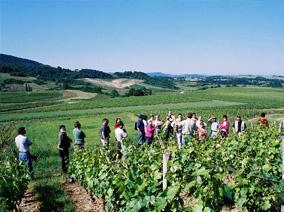
Winner in the Tourism and Local Intangible Heritage category
No detoxing allowed here – the first weekend in February in the Jura region in eastern France is fully dedicated to wine tasting.
The annual 'Percée du Vin Jaune' sees the opening and savouring of the first barrel of a new vintage of the Jura’s famous wine. It is the culmination of 6 years, 3 months and 10 days of fermentation of different varieties of grape that have been left unstirred in an oak barrel.
Since 1990, this special wine festival – now one of the biggest in France – has been successfully turned into a tourist attraction.
Visitors can follow the Jura wine route stretching 80km from Salins-les-Bains to Saint-Amour, highlighting the historical and cultural heritage of the region as well as its gastronomy.
This way, local businesses, wine producers and associated partners intend to promote their products and their region. A quality label 'Welcome to the Jura Wine Route' has also been set up.
The Jura route leads visitors through the region’s rich local heritage. Along it, they can discover more about:
- its internationally renowned spots – Arc et Senans, Baume-les-Messieurs, Chateau Chalon, Arbois and Lons-le-Saunier
- its historical and architectural heritage – wine-producing villages, old wine cellars and listed buildings
- local crafts – basketwork, pottery and art.
- its cuisine – cheeses, salted meats, honeys.
Year-round activities
The wine tasting festival is just one in a series of celebrations spread throughout the year. These include:
- June – Wine Producers’ Picnic
- July – Festi’Caves music festival
- August – wine-tasting fair, la Fête du Ploussard or la Fête du Trousseau
- September – wine producers’ ancestral festival, le Biou.
Other historical and tourist destinations can be visited throughout the year:
- waterfalls, a characteristic of the Jura’s mountainous limestone landscape
- steep gorges left by receding glaciers that cut through the main plateau
- caves
- salt marshes
- hot-springs.
Don't miss...
- the family home and vineyard of Louis Pasteur – France’s most famous scientist, and the father of modern oenology. His house in Arbois is open to visitors.
More information
- The official website of the Jura Wine Route
- Watch the EDEN video about the Jura Wine Route:
- Long version (3 minutes)
- Short version (1 minute)
- EDEN contact for the Jura Wine Rout: contact
 jura-vins [dot] com (contact[at]jura-vins[dot]com)
jura-vins [dot] com (contact[at]jura-vins[dot]com)
